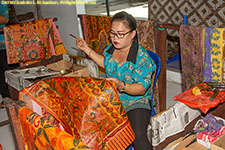
Ubud is Bali's cultural center, in the central foothills. It has a population of about thirty thousand.
Batik:
Batik designs are made by first drawing the pattern on white cloth. Areas not being dyed or painted are covered on both sides with wax (klowong) and then the cloth is dyed. Wax is then scraped off with a knife and reapplied as needed so that a second color can be dyed. The wax is removed by boiling the cloth. The finished batik is dried in the shade. Traditional dye colors are blue, brown, and light yellow.
Tegenungan Waterfall:
Tegenungan Waterfall is in Tegenungan Village, in Ubud.
Batuan Village:
Batuan dates from around 1000 AD. In the 17th century its royal family controlled much of southern Bali. This is a traditional Balinese house. The family shrines, kitchen, rice-barn, and other rooms are designed and located according to the Hindu emphasis on the ideal location to create harmony.
Tegallalang rice terraces:
The rice terraces on the side of the hills north of Ubud use the ancient Balinese Subak system to distribute water to all the farmers so that all fields can be irrigated.
Puri Saren Agung Ubud Palace:
The home of the local royal family, the palace stands in the heart of Ubud and is built in the style of a traditional family compound with its temple, Puri Saren Agung.
Ubud market:
Ubud Monkey Forest:
Mandala Wisata Wanara Wana is a sanctuary for about 750 long-tailed macaques. It also hosts three temples.
Goa Gajah elephant cave:
The 11th century cave was built as a place of meditation and for bathing in the sacred springs. Inside the T-shaped cave you can see fragmentary remains of the lingam, the phallic symbol of the Hindu god Shiva, and its female counterpart, the yoni, plus a statue of Shiva's son, the elephant-headed god Ganesha. In front of the cave are two square bathing pools. The site contains both Hindu and Buddhist imagery. The cave was rediscovered by Dutch archeologists in 1923, but the fountains and bathing pool were not discovered and excavated until 1954.
Mas Village and Hindu blessing:
Mas is a traditional village. Its name means "gold" in Bahasa Indonesia, but the primary craft in the village is woodcarving. The local priest (Brahman) performs fortune-telling using ancient methods, followed by a traditional Balinese blessing and purification ceremony conducted in the family temple.
luwak coffee:
Kopi luwak coffee is coffee brewed from ripe coffee beans that have passed through the digestive tract of the Asian palm civet (luwak), Paradoxurus hemaphroditus, a nocturnal cat-like civet native to Sulawesi, Sumatra, and Java. The partially-digested coffee berries are cleaned, sterilized, roasted, and ground. The taste is somewhat less acidic than normal coffee. Coffee from wild civets is very costly. There is much concern that the caged animals in these coffee plantations that produce kopi luwak may be mistreated.
Pura Gunung Kawi Sebatu Tegllalang is the less well-known of the two Gunung Kawi temples.
©2019 Mermaid Underwater Photographic. All Rights Reserved.
Contact us at mermaid@underwater.org.
Last modified 7 November 2019